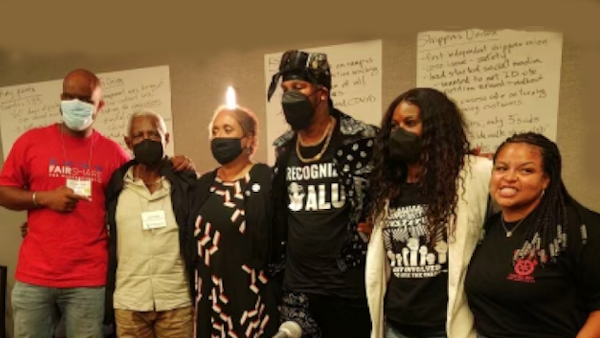
Toussaint Losier, UMass Amherst; Jerome Scott, League of Revolutionaries for a New America | League of Revolutionary Black Workers; Susan DeCarava, NewsGuild of NY; Chris Smalls, Amazon Labor Union; Stacy Davis Gates, Chicago Teachers Union; Brianca Cunningham, Action Center on Race and the Economy.
Over 4,000 workers gathered in Chicago in June. Workers flooded the first Labor Notes conference in four year. Working conditions have dramatically shifted since the last gathering. The state of the labor movement exists on new terrain.
Workers are called “essential” during the pandemic. Yet, bosses send us into the workplace among unsafe conditions. We are essential, and treated as disposable. Ultimately, workers know that everyone who punches a clock is essential. Everyone who labors for a wage to provide for their families are the backbone of the entire economy. By our sweat, we create all the wealth that exists.
Bosses have pushed back hard. Against rousing labor union drives at Amazon and Starbucks, management pulls no punches. Baristas and workers at Amazon are among the beating heart of labor. Their organizing is one example of a galvanizing wave of union activity.
Teamsters showed up to Labor Notes on the heels of a dramatic election for their union’s leadership. At the conference, they vowed to strike at UPS. If the company bosses refuse to bargain fairly in 2023, we will witness one of the largest and most disruptive strikes in decades.
Workers from across the world flew to the US to take part in the conference. Bangladeshi garment union activists shared what it takes to fight top retail brands. Student activists from Canada attended to share lessons from their efforts. Unionists from Australia, Brazil, Cameroon, Chile, China, the Democratic Republic of the Congo, Ghana, Ireland, Liberia, Mexico, Philippines, Norway and other countries connected their struggles at the International Guest Reception. The mood at the conference among workers from all industries was electric.
Attendees anticipated nothing less from the conference as they arrived in Chicago. Following the 2021 strike waves, workers arrived at the conference with wind in their sails. Throughout the pandemic, workers at Kellogg’s, Nabisco, and John Deere went on strike. Workers at Minneapolis Public Schools, Warrior Met Coal, and Cascade Behavioral Health had recently flexed their muscles on picket lines. Workers at RoozenGaarde Flowers and Bulbs, and countless others have fought to revive labor’s most powerful tool. They gathered in Chicago to share the lessons they have learned about organizing in times of crisis.
The conference featured over 100 workshops and training sessions. These sharpened the skills, strategies and analysis of rank-and-file unionists. Shop stewards, organizers and activists skilled up alongside workers. The conference offered a featured workshop track on Black workers and labor. In 2022, Black workers are more likely than any other group to be trade union members. This is an incredible achievement for Black liberation that shouldn’t be undervalued. At the same time, there is a long road ahead. This track included a panel discussion to anchor this fact in its historic context.
The podcast Black Work Talk recorded the intergenerational panel Black Labor Struggles Over Time. Panelists included: Stacy Davis Gates, the new president of the Chicago Teachers Union; Chris Smalls from the Amazon Labor Union; Jerome Scott from the League of Revolutionaries for a New America & League of Revolutionary Black Workers; and Susan DeCarava, of the NewsGuild of NY. You can listen to parts 1 and 2 of the panel at the following website: blackworktalk.com
During the panel, Jerome Scott noted, “We live in a capitalist, class society whose DNA is white supremacy. If we forget that in every one of our day-to-day struggles, we might win that struggle… but [those advancements will be] taken back. We got to think further than just achieving our immediate goals. If we don’t have any long-strategic goals, then we’re in trouble. And that obstacle, we must overcome.”
The conference also spotlit movement artists. These were unionists who use creativity to build a vibrant labor movement. This year’s conference hosted the Great Labor Arts Exchange. The Exchange featured songs, poems and plays about labor action. Writers and book sellers attended and passed along stories about labor history and labor’s future. Artist Ricardo Levins Morales received one of Labor Notes’ “Troublemaker Awards”. Morales has made revolutionary art for five decades. Throughout the conference hotel, attendees wore buttons of his work.
The main session on Friday evening boasted a blockbuster panel of rank-and-file leaders. As each speaker took the stage, the eruption of applause made it difficult to keep the ceremony moving. Senator Bernie Sanders (VT) wrapped up the ceremony. The Senator’s ability to get a crowd going is well-known. Yet, cheers for the Senator paled in comparison to the explosion of enthusiasm for workers. Rank-and-file workers from Amazon and Starbucks received a rock star’s welcome.
This, more than anything else, was a display of the priorities of those gathered in the room. Labor Notes insists that the beating heart of the labor movement is not found among those in positions of power, nor in positions of leadership in traditional trade unions. This heart beats in the rank-and-file workers that give life to the movement.
